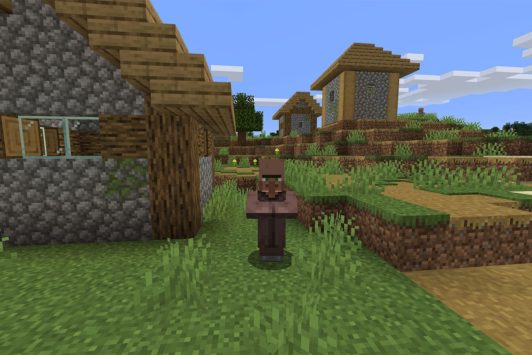Villagers are passive Non-Player Character types (NPCs) that spawn and move around in Villages. They have different roles, such as priests, butchers, blacksmiths, farmers, nitwit, and librarians and spawn in their respective buildings. They possess large, bald heads, green eyes, mono-brows, and long, huge noses.
Villagers are considered as one of the most intelligent of all peaceful mobs. However, there are some factors that they are unaware of or pay no attention to. Villagers realize the day-night cycle as well. Villagers are not fond of water, and unlike the other peaceful mobs, will immediately attempt to find an escape route. Villagers will attempt to avoid zombies. However, they do not attempt to escape any attackers except zombies. Unlike other mobs, villagers do not notice when they are set on fire, making any source of fire extremely harmful to a village’s population. Villagers won’t run if they are burning aswell, displaying no try to place the fire out.
Villagers only spawn in villages which may be located only in the flattest (or near to smooth ) biomes, such as for example desert biomes, savannas, and plains. Whenever a villager notices a zombie, they immediately start to hightail it from their website. Villagers are fast plenty of to flee a zombie. Nevertheless, this won’t constantly protect them. When it turns into nighttime, all villagers move in-doors to protection. However , there exists a flaw in this behavior. Whenever it really is raining outside, villagers still understand it as day time. Zombies, however , won’t die since it is raining, and sunlight is not out. This may trigger some villagers to die. Villagers may also run aside when they visit a Vindicator or an Evoker.
A prevalent view in a village will be villagers facing one another, assuming the human-like feature of “talking”. Whenever a player episodes a villager, they possess steam via their heads, most- most likely indicating anger or frustration. By 1 . 6, villagers will make noises (sounding similar to a “hmmm”, a grunt, or a humming audio ). They make sounds on several events: when breeding can be activated, when hit by a new player, or whenever a player trades with one.
Trading with Villagers
Villagers could be bartered with in the overall game for various products based on their ” career ” or kind of villager. The currency that they deal with are emeralds. Some villagers will trade for emeralds, while some will need emeralds and present products. Farmer type villagers, known for his or her brown clothes, are recognized to trade products linked to farming, such as for example wheat, carrots, potatoes, and melon seeds for emeralds, or vice versa. The butcher type, known for the brownish clothes and white apron, will trade for meats such as for example porkchops, beef, mutton, and poultry. It is a lot more common for the trade to need the raw edition of the meats. Priests, which may be identified by their complete purple clothes, trade for Ender Pearls and Eye of Ender. In addition they permit the player to get enchanted products by trading an unenchanted edition of that, and a few emeralds as the price of enchanting that. The blacksmith kind of villager trades for armor and equipment and weapons. The librarian villager is well known for his all white clothes and ” intelligent ” appear, buys paper and offers publication and navigational related products, such as for example bookshelves and compasses. Finally there is an added villager known as the Nitwit, it wears a green robe and will not trade when one correct clicks him.
Villagers all focus on one trade contract. Once the participant will this trade and closes the trading user interface, the villager could have a ” considering ” type animation and develop another trade. This will two things. Initial, it allows even more trading choices, up to maximum of 5 per villager, and second, it resets the trade. Each trade can be utilized 3-5 instances until it should be reset once again. The villager is only going to reset if the ultimate or “newest” trade is completed one or more times. Once all five are unlocked, continuing the last trade will continue steadily to reset the trades, and in addition has a little potential for replacing a preexisting trade with a fresh one.
Trading is among the fastest methods for getting emeralds legitimately in survival setting without the utilization of cheats, while farming pets and crops are much faster than digging for emeralds. This enables players to continuously trade and renew trades that yield emeralds to the participant. That is also known occasionally as “farming emeralds”, or “emerald bartering. “
By Minecraft 1 . 8, the villagers’ trading got a major upgrade. Villagers could will have many trades if they are spawned providing the participant more versatility when trading. Another element that helps can be that whenever trading, fresh trade possibilities may appear depending on just how many fresh trades players possess made already.
The Exploration Upgrade added new “cartographer” villagers, who’ll trade their Exploration Map for a Compass and varied levels of Emeralds gathered by the player.
Popularity with Villagers
A player’s reputation within a specific village could be increased or decreased in lots of ways, with one notable consequence: if the participant has a reputation below -15, naturally spawned Iron Golems can be permanently hostile towards the participant. Popularity could be obtained by trading, breeding, etc ., but will lower by attacking villagers and/or iron golems. A player’s popularity could be saturated in one village, however lower in another.
